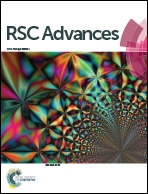The cleavage of perylenequinones through photochemical oxidation acts as a detoxification mechanism for the producer†
Abstract
Perylenequinones (PQs) belong to a class of photosensitizers, generated by some fungi for parasitization or combating invaders. However, PQs generate reactive oxygen when exposed to light irradiation and cause nonselective damage to the producer host. The mechanism underlying the self-resistance of the producer is less understood. By using high-performance liquid chromatography and UV-visible absorption spectroscopic analysis, we found that PQs from an endolichenic fungus Phaeosphaeria sp. were transformed into new derivatives when the culture was exposed to visible or ultraviolet light. This transformation was accompanied by the reduction of its antimicrobial activity. In order to unveil the underlying mechanism, the purified hypocrellin A and calphostin D were employed in the photochemical analysis. The obtained light cleaved products were found to be nontoxic to the tested microbes and this photo-driven detoxification could be taken as a self-resistant strategy for the producer.


 Please wait while we load your content...
Please wait while we load your content...